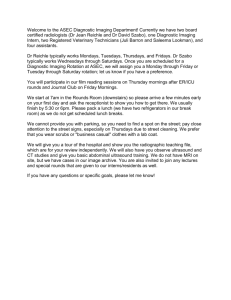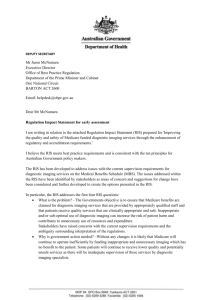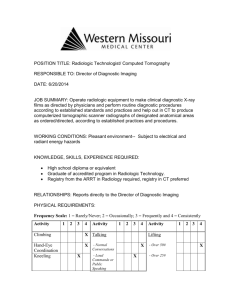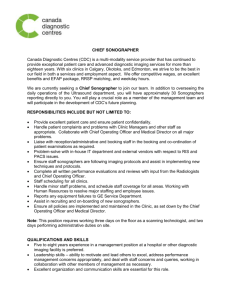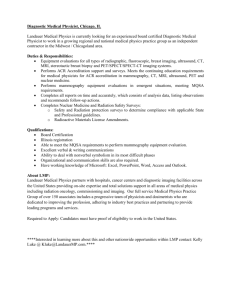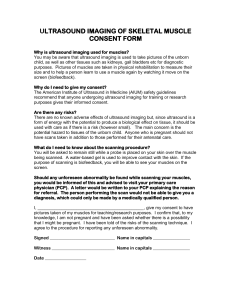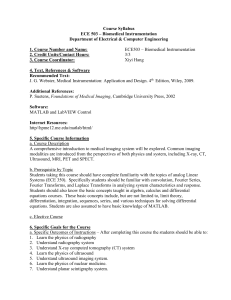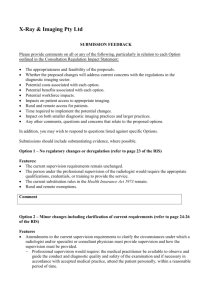Version - Word 47 KB
advertisement
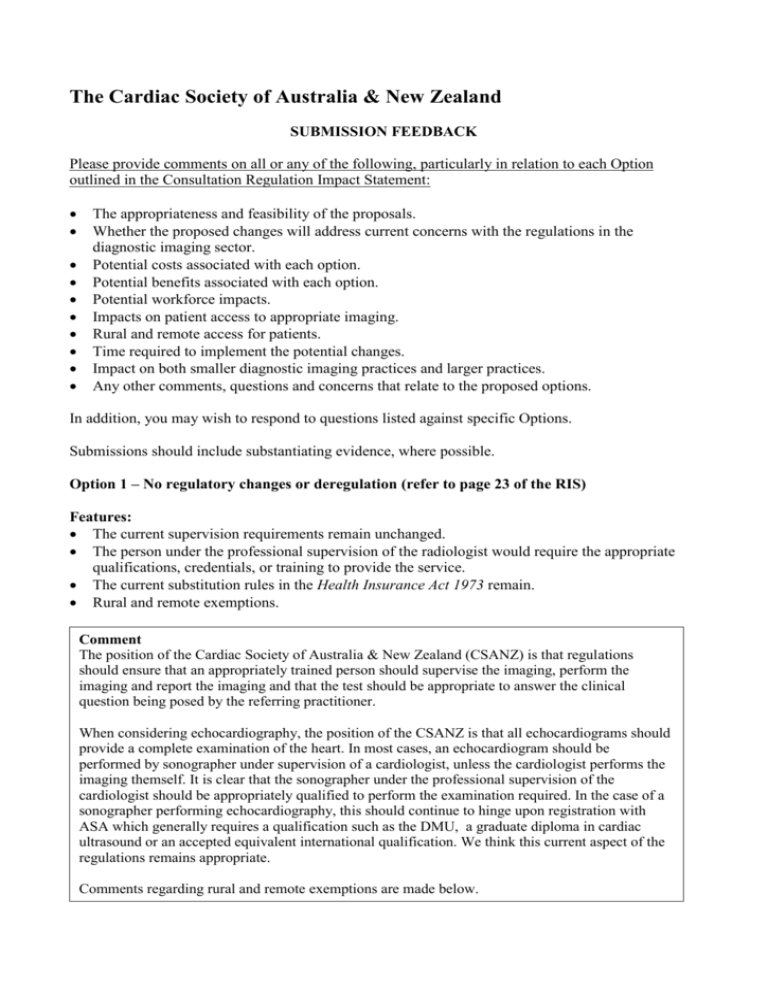
The Cardiac Society of Australia & New Zealand SUBMISSION FEEDBACK Please provide comments on all or any of the following, particularly in relation to each Option outlined in the Consultation Regulation Impact Statement: The appropriateness and feasibility of the proposals. Whether the proposed changes will address current concerns with the regulations in the diagnostic imaging sector. Potential costs associated with each option. Potential benefits associated with each option. Potential workforce impacts. Impacts on patient access to appropriate imaging. Rural and remote access for patients. Time required to implement the potential changes. Impact on both smaller diagnostic imaging practices and larger practices. Any other comments, questions and concerns that relate to the proposed options. In addition, you may wish to respond to questions listed against specific Options. Submissions should include substantiating evidence, where possible. Option 1 – No regulatory changes or deregulation (refer to page 23 of the RIS) Features: The current supervision requirements remain unchanged. The person under the professional supervision of the radiologist would require the appropriate qualifications, credentials, or training to provide the service. The current substitution rules in the Health Insurance Act 1973 remain. Rural and remote exemptions. Comment The position of the Cardiac Society of Australia & New Zealand (CSANZ) is that regulations should ensure that an appropriately trained person should supervise the imaging, perform the imaging and report the imaging and that the test should be appropriate to answer the clinical question being posed by the referring practitioner. When considering echocardiography, the position of the CSANZ is that all echocardiograms should provide a complete examination of the heart. In most cases, an echocardiogram should be performed by sonographer under supervision of a cardiologist, unless the cardiologist performs the imaging themself. It is clear that the sonographer under the professional supervision of the cardiologist should be appropriately qualified to perform the examination required. In the case of a sonographer performing echocardiography, this should continue to hinge upon registration with ASA which generally requires a qualification such as the DMU, a graduate diploma in cardiac ultrasound or an accepted equivalent international qualification. We think this current aspect of the regulations remains appropriate. Comments regarding rural and remote exemptions are made below. Option 2 – Minor changes including clarification of current requirements (refer to page 24-26 of the RIS) Features Amendments to the current supervision requirements to clarify the circumstances under which a radiologist and/or specialist or consultant physician must provide supervision and how the supervision must be provided. - Professional supervision would require: the medical practitioner be available to observe and guide the conduct and diagnostic quality and safety of the examination and if necessary in accordance with accepted medical practice, attend the patient personally, within a reasonable period of time. The personal attendance requirement of musculoskeletal ultrasound would be amended to align with all other ultrasound items. The person under the professional supervision of the radiologist would require the appropriate qualifications, credentials, or training to provide the service. The current substitution rules in the Health Insurance Act 1973 remain. Rural and remote exemptions. Specified qualification requirements for ultrasound providers. Definition of diagnostic ultrasound. Comment As detailed above, the position of the Cardiac Society of Australia & New Zealand is that regulations should ensure that an appropriately trained person should supervise the imaging, perform the imaging and report the imaging and that the test should be appropriate to answer the clinical question being posed by the referring practitioner. Supervision requirements The Cardiac Society does not feel that it is appropriate or practical for a cardiologist to personally observe each examination nor attend all patients undergoing transthoracic echocardiography imaging by a sonographer under the supervision of that cardiologist at the time of the examination. In the case of transoesophageal and stress echocardiography, attendance of the cardiologist is required because of the nature of these imaging procedures. If there were to be clarification around supervision requirements and personal attendance, it would not be practical in the case of cardiology practice and cardiac ultrasound for the cardiologist to personally attend all examinations. Although many cardiologists provide imaging services, imaging is not their exclusive practice and patient consultation and direct care form a significant and important part of most cardiology practice. For example, if a cardiologist is attending patients in hospital at a time when an ultrasound examination is scheduled to be performed, it would not be reasonable for that examination to be delayed. It is also possible in the case of self-determined examinations that the cardiologist has seen the patient prior and will see the patient subsequent to the examination. Almost all examinations are complete, protocol driven studies with scanning performed by highly trained sonographer. In the uncommon situations where attending the patient personally is required, attendance on the same day or within 24 hours would seem reasonable definitions to consider. Any change to require personal attendance at the time of the examination would have severe impacts on the provision of many aspects of clinical cardiology services, in particular for those practitioners who do not work within a large group practice, without necessarily improving the quality of the imaging services provided. As stated above, use of a sonographer under supervision requires that sonographer to be highly trained and appropriately qualified. In the case of cardiac ultrasound, registration with ASA should continue to be a requirement. Qualifications for ultrasound providers It should be acknowledged that all cardiologists who have completed advanced training in accordance with the RACP/CSANZ Cardiology Training Syllabus, which mandates extensive documented echocardiography experience, are appropriately qualified to perform and report transthoracic echocardiography. We feel that in cases where training in performing and reporting of the specific imaging technique is a mandated part of advanced training for that specialty, as is the case for transthoracic echocardiography and advanced cardiology training to receive FRACP in Cardiology though the RACP, that an additional qualification such as a DDU should not be required. We believe this is also the case for advanced training in vascular surgery where training in vascular ultrasound is mandated. The current “CSANZ Position Statement on Training and Performance in Adult Echocardiography”1 details the standards required by the CSANZ. Where there is no such mandated training in the curriculum of the college, a certified qualification such as the DDU would seem a reasonable requirement. We do point out, however that within the CSANZ position statement and training guidelines, we would not regard someone who has completed only the mandatory requirements of advanced cardiology training to be qualified to independently perform and report transoesophageal and stress echocardiography, as these are more advanced cardiac ultrasound modalities. These require additional training and we have suggested that this may best be obtained through a dedicated training fellowship, which we would regard as being adequate training without requirement of a DDU. Definition of diagnostic ultrasound This is clearly an area where additional work is required due to the availability of cheap ultrasound machines, which may not feature all the imaging modalities expected for a comprehensive diagnostic echocardiogram, and can result in point of care examinations of variable quality which we do not feel should qualify for Medicare funding using the current echocardiography item numbers within the DIST. There are elements which we believe differentiate diagnostic ultrasound from point of care ultrasound (which to some degree is an extension of the patient examination), such as referral from a medical health care provider in most cases, performance by highly qualified sonologists and sonographers using high quality ultrasound equipment, the use of a comprehensive imaging protocol tailored both to the clinical question AND findings which are identified during the examination, the provision of a report which may provide the referrer with guidance about the significance of findings and logical next steps in patient management and, finally, storage of the images for future review and reference. We do point out, that because of the nature of consultant cardiology practice, there are cases where it is determined by a cardiologist who also provides imaging services, that cardiac ultrasound is necessary, and therefore the referral does not come from an outside provider. These examinations are also comprehensive and fulfill all the other requirements of diagnostic ultrasound and carry the same diagnostic value. We have provided guidance on the key elements of a satisfactory diagnostic transthoracic echocardiogram in our position statement on echocardiography training and standards1. 1 http://www.csanz.edu.au/wp-content/uploads/2015/04/Adult-Echo_2015-February.pdf Musculoskeletal Ultrasound (refer to page 25-26 of the RIS) Questions: Are the principles as outlined satisfactory to clarify the requirements? What reasons, if any, are there for the personal attendance requirements for musculoskeletal ultrasound to remain? Would a minimum set of guidelines for ‘accepted medical practice’ per modality be appropriate? What savings are anticipated to be realised from removing the personal attendance requirements for musculoskeletal ultrasound services? What additional costs are anticipated to be incurred by requiring a medical practitioner (eg radiologist) to be in close proximity to attend on a patient personally within a reasonable period of time in circumstances where this is not currently the situation? What other costs (if any) might be associated with the proposed changes? What are the potential consequences of the proposed changes? Comment Not relevant to cardiac practice. Option 3 – Practice based approach (refer to page 27-34 of the RIS) Features Amendments to the current supervision requirements to clarify the circumstances under which a radiologist and/or specialist or consultant physician must provide supervision and how the supervision must be provided. - Professional supervision would require: the medical practitioner be available to observe and guide the conduct and diagnostic quality and safety of the examination and if necessary in accordance with accepted medical practice, attend the patient personally, within a reasonable period of time. The personal attendance requirement of musculoskeletal ultrasound would be amended to align with all other ultrasound items. The person under the professional supervision of the radiologist would require the appropriate qualifications, credentials, or training to provide the service. Computed Tomography services would only be able to be provided in a comprehensive practice, with the exception of CT of the coronary arteries (items 57360 and 57361). Supervision would be tailored to the type of diagnostic imaging practice. A comprehensive practice would require a radiologist to be available during agreed operating hours. Where a radiologist is on site during ordinary operating hours, the radiologist would be allowed to determine the supervision requirements for the practice and have the flexibility to implement and supervise efficient and effective processes. Where a radiologist is on site during ordinary operating hours, the radiologist would be allowed to substitute a requested service for a more appropriate service, without the need for consultation with the requester, if the substituted service has a lower MBS fee than the requested service. The current substitution rules in the Health Insurance Act 1973 remain. Where a radiologist is NOT on site during ordinary operating hours, a radiologist must be on site for the performance of the following services: o Mammography; o The administration of contrast; and o Image guided intervention procedures/surgical interventions. The reporting and supervising radiologist would not have to be the same person, but practices would be required to maintain records which indicate the name of all the radiologists involved in the service. Rural and remote exemptions. Specified qualification requirements for ultrasound providers. Definition of diagnostic ultrasound. Comment Comments made regarding option 2 around appropriate qualification of providers of imaging services, supervision and definitions would still apply. If a comprehensive service were to offer echocardiography, the provider would need to be appropriately trained in this specialised modality though a recognized training program or provide evidence of an appropriate qualification in this modality. A Comprehensive practice (refer to page 28-29 of the RIS) Questions: Are there any other types of practices which have not been identified? Are there comprehensive practices that do not currently have a radiologist onsite? What are the costs of employing a radiologist onsite during ordinary operating hours? What are the costs of non-comprehensive practices expanding to become comprehensive practices? Are there enough radiologist for this to occur? What are the barriers? Is there any role for standalone CT and, if so, how would current safety and quality concerns be addressed? What will be the impact of this change on providers and patients? What other costs (if any) might be associated with the proposed changes? What are the potential consequences of the proposed changes? Comment For comprehensive practices that offer echocardiography, these involved in the provision of this service should be specifically and appropriately trained in echocardiography as outlined in Option 2 above. Non-radiologist specialist practice (refer to page 30-31 of the RIS) Question Are there any other services currently performed by non-radiology specialists? Comment If this approach is taken, cardiologists would clearly fall under this category. They provide cardiac ultrasound (echocardiography) services, CT coronary angiography and at present, an application is pending for cardiac MRI services, which may be performed by a cardiologist, often conjunction with a radiologist. All of these diagnostic imaging services would need to be considered is this approach were taken. It may allow regulations to be better tailored to these practices which do not fit the traditional radiology practice model. ADDITIONAL ISSUES FOR CONSULTATION 1. Rural and remote exemptions (refer to page 31-32 of the RIS) The intention of having rural exemptions is to ensure patients have access to services without compromising on quality. However, current arrangements for rural exemptions vary for each of the modalities, creating confusion due to an inconsistent approach. The current approach is also difficult to administer. Questions Does the current rule meet its goal of increasing access for patients without comprising on quality? Should exemptions be geographically/distance based rather than looking at population base and local availability of specialist services? Are there any other mechanisms that provide incentives for local services provision in rural Australia? What is the role of tele-radiology? Should it be the only service, or an adjunct the local service provision? Should the exemption not be available for certain types of services? Comment It remains important to provide opportunity for individuals in rural and remote areas to access high quality diagnostic imaging close to home where possible. We agree that the current exemptions are somewhat difficult to administer. It is also worth pointing out that the definition of a remote area within the regulations is centred around the distance from the nearest radiology service or radiology facility. This may be problematic where the diagnostic imaging services are not those routinely provided by a radiology service, such as echocardiography. An additional challenge is that the quality of a service is not part of the exemption criteria. At present the provision of a poor quality service in a rural area, may mean that additional providers who may wish to provide a service of higher quality, are unable to access a rural and remote exemption because of service which is effectively blocking their entry. Consideration may need to be given regarding how this should be addressed. Due to changes in imaging practice which have already happened and which may happen in the future, the implications of tele-radiology need to be considered, as acquisition of images under supervision which are reported remotely is likely to be an increasing practice within diagnostic imaging. It is possible that embracing tele-radiology may result in enhanced diagnostic imaging services, both in terms of access and quality, in rural areas in the future rather than detracting from the services provided. This will have implications for the definition of adequate supervision. 2. Implementing any changes and the relative role of regulation and the Diagnostic Imaging Accreditation Scheme (DIAS) (refer to page 33-34 of the RIS) The relative role of regulation and accreditation in enhancing the quality framework for MBS funded diagnostic imaging services will be determined following feedback received from stakeholders under this consultation process. Questions Would changes to supervision be better placed in the DIAS or remain in the regulations? How would a practice based supervision approach be incorporated into regulation? Is it necessary to have a modality based approach in the regulations (as a minimum) and a practice based approach in accreditation? Comment We would suggest any changes to supervision remain in the regulations rather than the DIAS. At least then compliance with the supervision requirements can be linked to a particular instance. 3. Any additional proposals, suggestions or comments? Comment We have focused our comments on aspects of the proposal which may impact on diagnostic imaging services provided by cardiologists, which is predominantly echocardiography. Where proposed changes affect radiology practice, without any implications for echocardiography, we have not made comment as the radiology community would seem best qualified to address these. We do point out that because not all diagnostic imaging practices are the same, it remains important that the framework of regulation remains appropriate for those practices which do not fit the model of a traditional radiology practice. There are almost no cardiologists who perform diagnostic imaging in a full-time capacity, but generally combine this aspect of practice with consulting and other diagnostic and therapeutic procedures. For that reason, regulations around attendance and supervision must take into account this difference in pattern of practice and ensure that any changes are workable and enhance imaging quality and access rather than detract from these. In addition, it is necessary to ensure that any changes to the current regulations do not have the unintended effect of having a negative impact on the delivery of other important aspects of clinical cardiology care outside the diagnostic imaging sphere. It is likely that similar concerns are relevant to other imaging groups such as obstetrics and gynaecology and vascular surgery.

